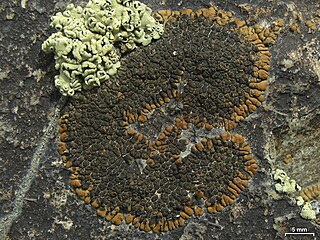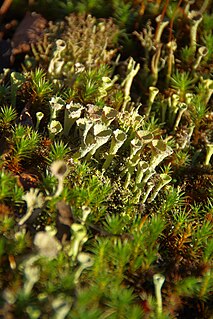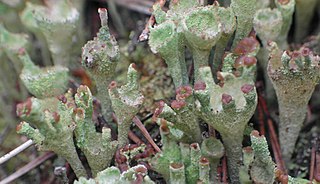
Sphaerellothecium is a genus of fungi in the family Phyllachoraceae. All of the species in the genus are lichenicolous, meaning they grow parasitically on lichens.
Merismatium is a genus of lichenicolous (lichen-dwelling) fungi of uncertain familial placement in the order Verrucariales. The genus was circumscribed in 1898 by Friedrich Wilhelm Zopf.

Phacopsis is a genus of lichenicolous (lichen-dwelling) fungi. They are parasites of members of the large lichen family Parmeliaceae, of which they are also a member. Originally proposed by Edmond Tulasne in 1852 to contain 3 species, Phacopsis now contains 10 species, although historically, 33 taxa have been described in the genus. Many of the species are poorly known, some of them having been documented only from the type specimen.

Cladonia carneola or the crowned cup lichen is a species of fruticose, cup lichen in the family Cladoniaceae. It was described as a new species by Swedish mycologist Elias Magnus Fries. Lichenicolous fungi that have been recorded growing on Cladonia carneola include Phaeopyxis punctum and Taeniolella beschiana.

Cladonia pyxidata or the pebbled cup lichen is a species of cup lichen in the family Cladoniaceae. It is host to the lichenicolous fungus Lichenoconium pyxidatae.

Stereocaulon alpinum is a species of fungus belonging to the family Stereocaulaceae. It is similar to Stereocaulon paschale but differs from it in containing cyanobacteria of the genus Nostoc while S. paschale contains cyanobacteria of the genus Stigonema, which have a darker colour than Nostoc.
Lichenopeltella cladoniarum is a species of fungus belonging to the class Dothideomycetes. It has been found growing on the podetia of Cladonia arbuscula in Bulgan district, Mongolia and Yamanashi prefecture in Japan.
Lichenopeltella uncialicola is a species of fungus belonging to the class Dothideomycetes. The species was discovered in Iceland in 2010 where it was found growing on Cladonia uncialis. Since then, it has been found on a different host species, Cladonia rangiferina, in North-Korea, Italy Austria, and Greenland.
Lichenoconium pyxidatae is a species of lichenicolous fungus belonging to the class Dothideomycetes. It has a Holarctic distribution being found in Alaska and various parts of Russia, including Siberia, Franz Josef Land, Novaya Zemlya and Wrangel Island.

Muellerella pygmaea is a species of lichenicolous fungus in the family Verrucariaceae. It has a cosmopolitan distribution in Arctic-alpine areas and grows on the thallus and apothecia of a number of hosts.
Stereocaulon subcoralloides is a species of snow lichen belonging to the family Stereocaulaceae.
Stereocaulon glareosum is a species of snow lichen belonging to the family Stereocaulaceae.
Stereocaulon intermedium is a species of snow lichen belonging to the family Stereocaulaceae.
Stereocaulon depressum is a species of snow lichen belonging to the family Stereocaulaceae.
Stereocaulon rivulorum is a species of snow lichen belonging to the family Stereocaulaceae.
Cercidospora stereocaulorum is a species of lichenicolous fungus in the genus Cercidospora but it has not been assigned to a family. It is known to parasitise lichens of the genus Stereocaulon.
Sphaerellothecium araneosum is a species of lichenicolous fungus in the family Phyllachoraceae.
Polycoccum laursenii is a species of lichenicolous fungus in the family Polycoccaceae. It was first described as a new species in 2004 by Russian mycologist Mikhail Petrovich Zhurbenko. It is found in Alaska and in Russia.
Arthonia stereocaulina is a species of lichenicolous fungus in the family Arthoniaceae.
Cercidospora macrospora is a species of lichenicolous fungus in the genus Cercidospora but it has not been assigned to a family. It is known from the northern hemisphere.






